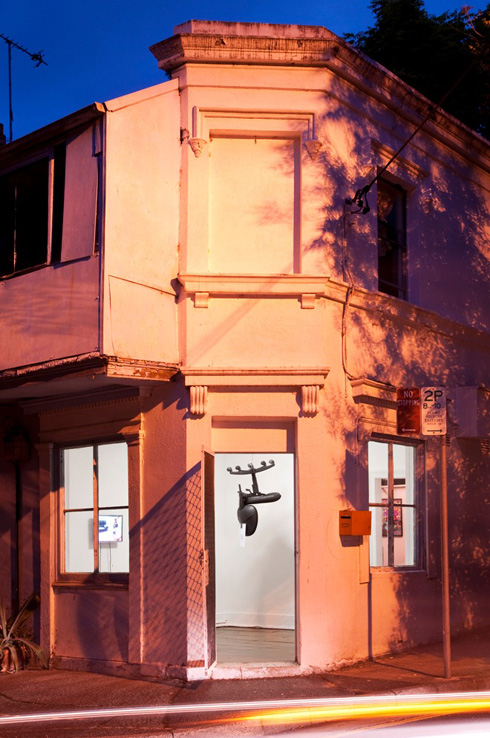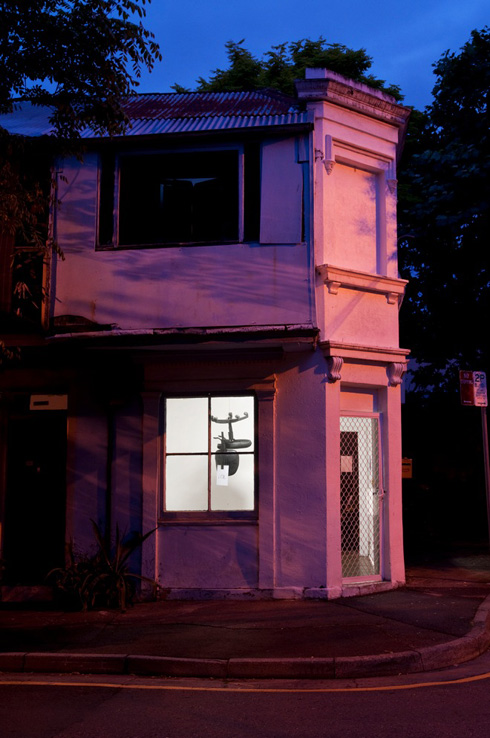Chairs Missing

 Text: Joel Draper Images: Craig Bender
Text: Joel Draper Images: Craig Bender
Artist Run Initiatives a.k.a. ARIs are a crucial wrung on the Australian gallery hierarchy. They provide a platform – an opportunity for intellectual rigour and hands-on experience – for young artists desperately seeking an audience. Very few artists progress directly from their final year show to a commercial or institutional gallery, and that’s where ARIs come in. Directors of these spaces are often practicing artists and act as custodians, providing opportunities that would not otherwise be afforded to younger artists.
Christopher Hanrahan and Elizabeth Reidy may not be household names but they have worked diligently on a number of gallery spaces, including Chalkhorse, Firstdraft, Phatspace and Gallery Wren. Now, Hanrahan has opened the doors of his Surry Hills abode with db projects, to what I’m sure will soon be the flocking masses, hungry for the next big thing in Australian art.
The first time I interviewed Hanrahan, my recording device devilishly didn’t work. While I panicked at home, he basked in the sunshine at a Sheffield Sheild game. I frantically contacted him to explain the situation and he calmly said we could do it again. So, here is take-two of my interview with Christopher Hanrahan, the redheaded art mogul from Phelps Street.
Joel Draper: How was the cricket yesterday?
Christopher Hanrahan: The cricket was great. One-dollar entry and maybe 40 people all up in the crowd at the SCG. Michael [Moran] worried me a little on the way in with a suggestion that perhaps there would be a large crowd in attendance as all the star players would be on show. Thankfully, he was very wrong.
JD: How did db projects get started?
CH: db began somewhat opportunistically. We had a room in our house that was either poorly used or not at all. Both Liz [Reidy] and I had run artist-run spaces in the past and had no desire to revisit that, but felt as though we had a good opportunity to develop a model which would be sustainable and not too taxing on our resources and time.
JD: You run db projects in your house. You’re not the first to do this: there was Marcel Broodthaers in Belgium in the late 1960s, and there have been instances in Australia. One of the most prominent would have been Liz Pulie and Jay Balbi’s Front Room, which was on City Road in Sydney. What is the appeal of running a gallery in your living room? And is the viewing experience different?
CH: The appeal of running a space from home is that it becomes manageable and not too financially draining. While we may sacrifice the ability to host larger works or projects, we can substitute that with focused presentations that have burdens such as space rental (for the artist) and ongoing maintenance (for the directors) removed. This is very similar to the set-up of [Alexandria’s Locksmith Project Space]. The viewing experience is tempered by the fact you are in someone’s home. Most visitors that aren’t close friends certainly enter the space with some trepidation. Further still, we have exacerbated that situation by hosting works in the toilet out the back which means people have to actually walk through the domestic space to get to the second show.
JD: We have spoken before about ARIs being a site of control for the director/artists. I saw Tracey Emin speak a couple of weeks back. She spoke of the Young British Artists opening their own spaces in London’s East End and the power shift that took place. Suddenly the art world had to leave Cork Road and participate on the artists’ terms. Do you feel something similar happening in Sydney?
CH: It’s similar in that the major commercial galleries are predominantly located around Paddington and the city, and the rent in those areas is prohibitive for ARIs – other than that, no. A lot of the focus on those East End spaces came through a tabloid interest in the artists themselves. That, and also a city with more than five major newspapers have a lot of copy to fill. Visual arts in Sydney have to struggle for any mainstream coverage. The coverage it does receive is mediated and, in the end, essentially paid for. So publicity is inherently harder to generate, therefore the collectors with the money to direct or even dictate the market – who you would have to assume are incredibly busy making that money – either don’t know about the spaces or are very selective as to where they put their money. Commercial spaces are seen as a safer investment and there is certainly no Charles Saatchi here.
JD: Do you feel ARIs are given enough attention? With a few new ARIs opening up this year, how do you see the art scene developing in Sydney?
CH: It would be nice to get more interest from art schools but I think that’s something that we will have to initiate, rather than the other way around. What would be great, and a complete shock, would be to see some Curatorial Studies students taking an interest – but they all seem to be dreaming of a job licking envelopes in commercial spaces rather than genuinely developing a serious curatorial practice. The ARI scene seems quite healthy, with some great new spaces mixing well with the existing ones. It’s like a trade fair where people seem to like each other, which is good.
JD: What’s coming up for db?
CH: The Woody Allen Larry David show, which has been postponed until next year because I’m going away, then a veritable cavalcade of visual art and maybe a performance collaboration between Brian Fuata and Michael Moran – hopefully.
DB Project Space
Next story: Magic Sceptre – Straight Arrows




